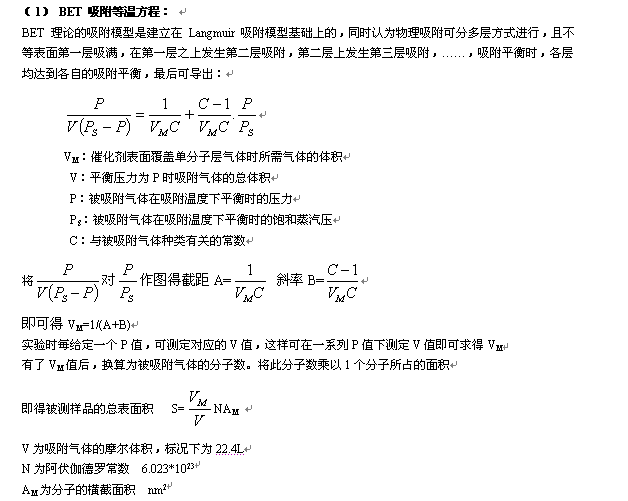1.
Specific surface area of the catalyst
:
Refers to the total internal and external surface area per unit mass of a porous material.
Unit:
m2/g
2.
For porous catalysts or carriers
:
| Measurable method | Total specific surface area | Active specific surface area |
| BET Method, Chromatography | Chemical adsorption method, Chromatography |
3. BET Adsorption isotherm equation
——BET Specific surface (currently recognized as the standard method for measuring the specific surface area of solids)

(2) A common method for determining the amount of gas adsorbed:
1. Volumetric method
The specific surface area is calculated by measuring the volume difference between the gas before and after adsorption. The sample is first degassed, then the adsorption process is carried out.
2. Gravimetric method
This method uses a high-sensitivity quartz spring scale to measure the elongation caused by the adsorption of a small amount of gas. It can handle multiple samples at once, but its accuracy is lower than the volumetric method and is typically used for samples with a surface area greater than 50 m2/g.
3. Gas chromatography
Gas chromatography doesn't require a high vacuum system and is faster and more sensitive than traditional methods, making it suitable for industrial use. In this method, the solid itself acts as the stationary phase, and gases like N2, H2, etc., are used as the carrier gas.
4. Separating different specific surface areas in complex catalysts
Using physical adsorption methods, only the total surface area can be measured, not the active surface area of individual components. Selective chemisorption is often used to determine the surface area occupied by different components. This involves finding gases that react selectively with one component without affecting others.
However, due to the complexity of chemisorption, only a few catalysts have been successfully measured using this method.
For example, in Pt/Al2O3 or Pt/SiO2-Al2O3 catalysts, hydrogen, oxygen, or carbon monoxide can be used to measure the exposed platinum surface. Before measurement, the sample is degassed to ensure a clean surface.
Hydrogen chemisorption is commonly used. Under appropriate conditions, each platinum atom adsorbs one hydrogen atom, allowing calculation of the number of exposed platinum atoms and thus the surface area.
Similarly, oxygen titration can be used to calculate the surface area of platinum based on the reaction between hydrogen and adsorbed oxygen.
5. Determining the surface area of copper oxide and cuprous oxide
In copper-based catalysts, CuO and Cu2O exist in dynamic equilibrium. Their different chemisorption capacities for oxygen and CO are used to distinguish them. For instance, CuO reacts with CO, while Cu2O reacts with O2.
By measuring the adsorption of O2 and CO, the surface areas of CuO and Cu2O can be determined using a set of equations based on known adsorption values.

6. Specific surface <1 m2/g
Low temperature nitrogen adsorption has a lower limit of about 1 m2/g. For very low surface area samples, helium is preferred because of its high sensitivity and accurate measurement capabilities under certain conditions.
7. Determining active surface area
The BET method measures the total surface area, but only a portion is active. Selective chemisorption methods, such as hydrogen peroxide titration, are used to measure the active surface area.
Many high surface area adsorbents have pores. The outer surface includes all protrusions, while the inner surface refers to the walls of cracks and holes deeper than their width.
8. Langmuir Adsorption Isotherm Equation
——Langmuir Specific Surface
(1) Langmuir theoretical model: Uniform surface, no interaction between adsorbed particles, single-layer adsorption, and equilibrium between adsorption and desorption rates.
(2) Isothermal equation: Ra = ka(1-θ)P, Rd = kdθ. At equilibrium, ka(1-θ)P = kdθ. Solving gives θ = BP/(1 + BP).
Plotting P/V vs. P yields a straight line. From the slope and intercept, B and Vm can be determined. The specific surface area Sg = Vm * A * σm, where A is Avogadro's constant and σm is the cross-sectional area of an adsorbate molecule.
This formula applies to pure microporous materials and chemical adsorption processes.
Dongguan Pinji Electronic Technology Limited , https://www.iquaxusb4cable.com